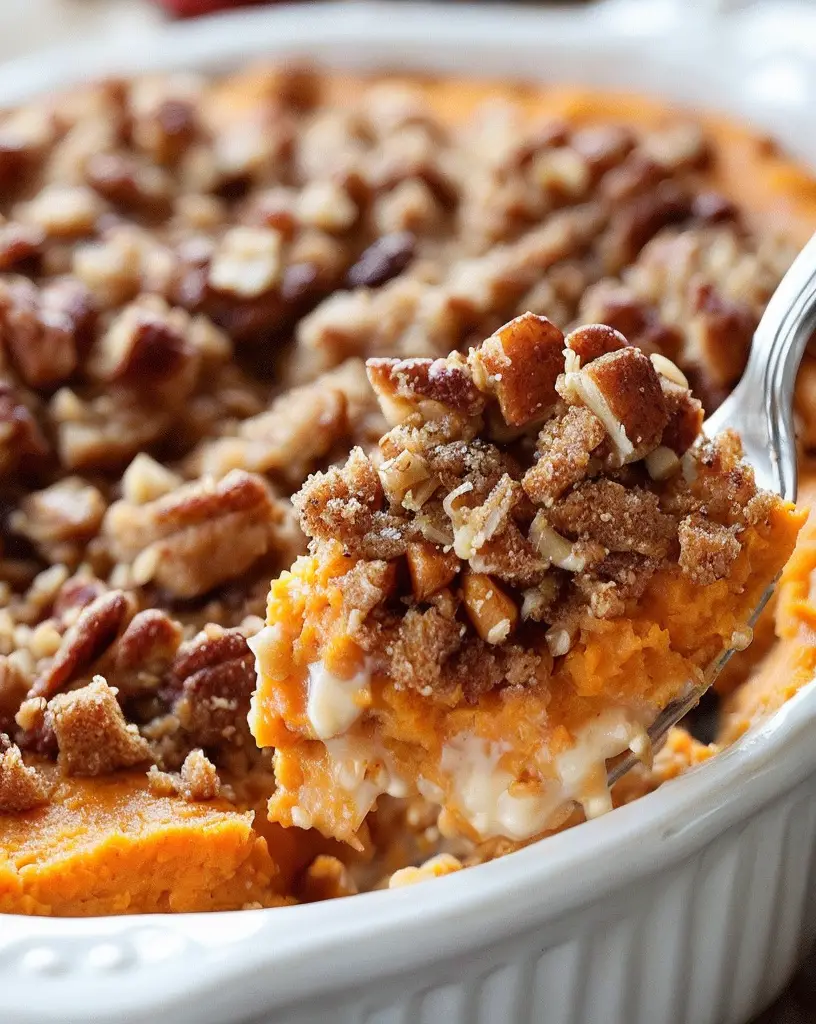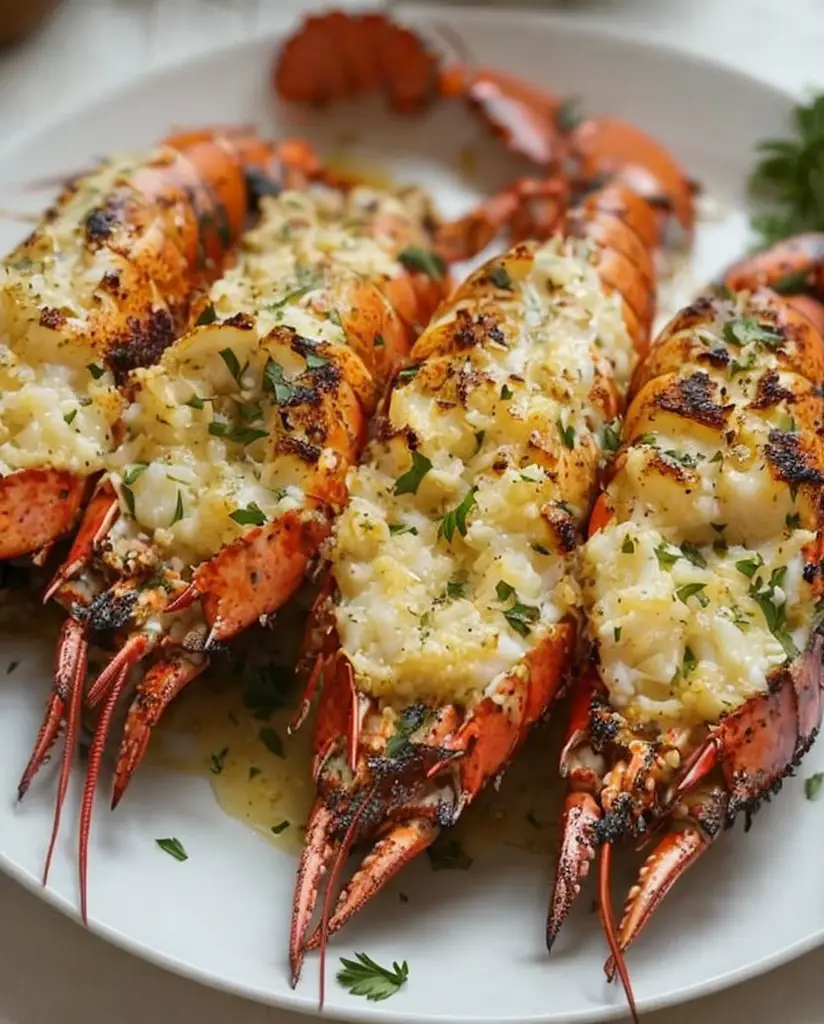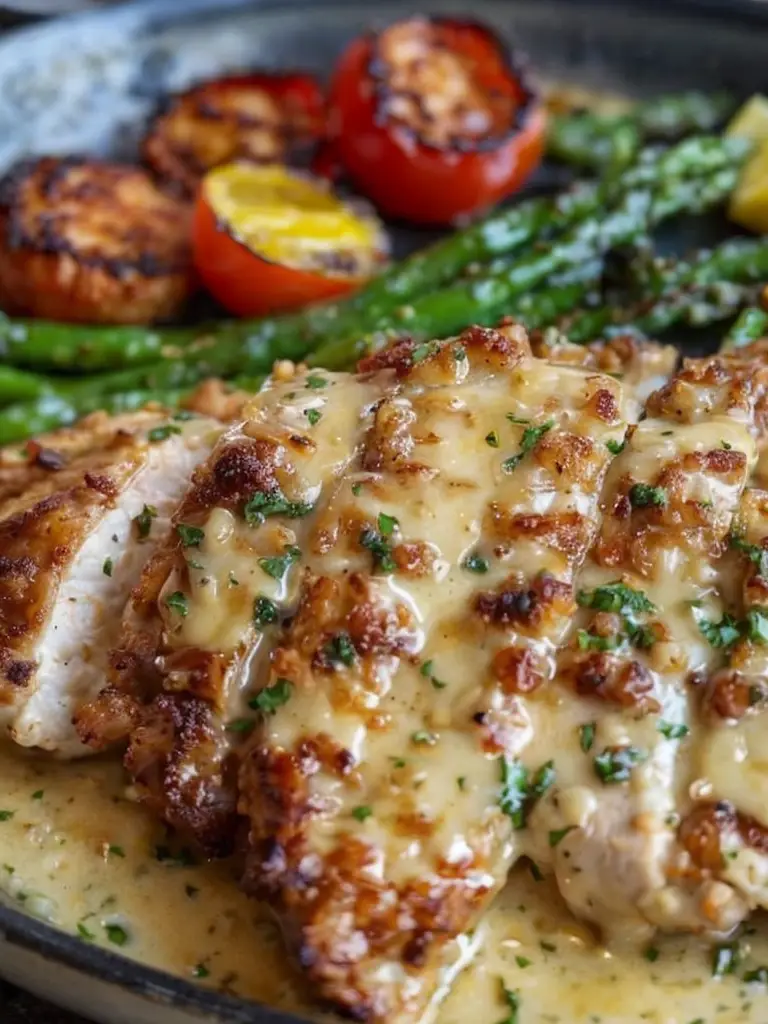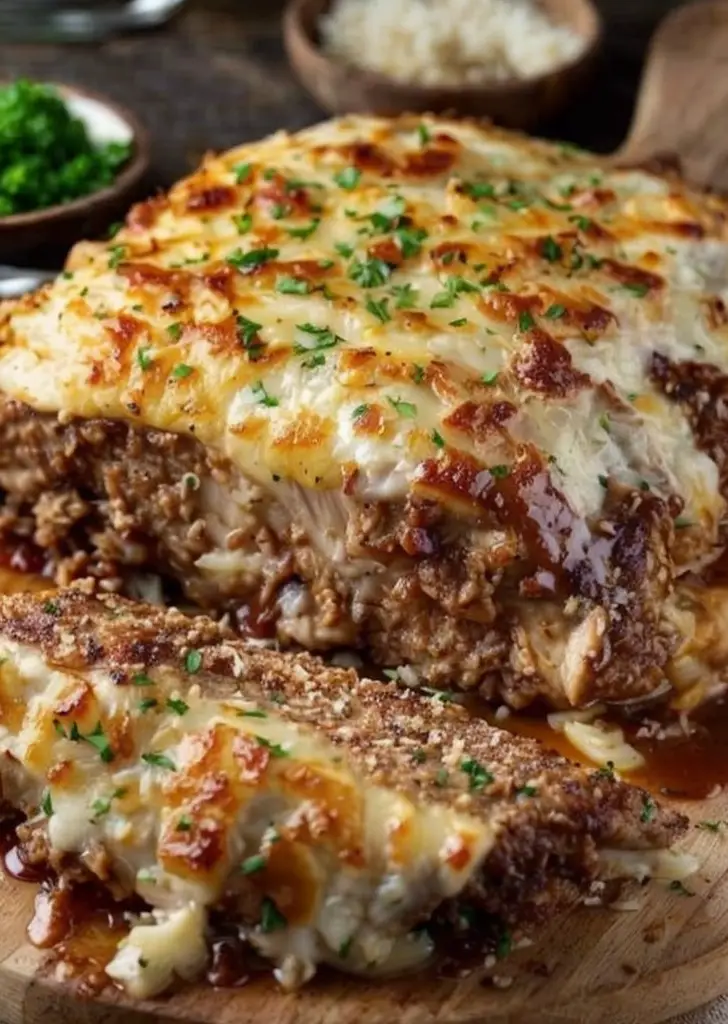Sweet Potato Casserole Recipe – Perfect Holiday Side Dish
Sweet Potato Casserole is the star side dish of any holiday feast, bringing together creamy layers of sweet potatoes with a delightful, crunchy topping that is simply irresistible. Whether you’re hosting a large family gathering or a cozy dinner with friends, this dish promises to be a crowd-pleaser. Its vibrant orange color sets a festive tone on your dining table, while the mix of textures and flavors provides a comforting experience with every bite.
Indulge in the perfectly balanced taste of sweet potatoes enhanced by the warmth of cinnamon and nutmeg, and topped with a buttery pecan crumble. The delightfully creamy interior contrasts beautifully with the crispy topping, creating a dynamic tasting experience. The aroma of this casserole, as it bakes, fills your home with a sweet, cozy fragrance that hints at the deliciousness to come.
Quick Recipe Highlights
- Flavor Profile: The sweet potatoes are sweet and spiced, perfectly balanced with a buttery pecan topping.
- Texture: Creamy and smooth with a contrasting crunch from the pecan topping.
- Aroma: Sweet with hints of cinnamon and nutmeg, filling your home with a holiday scent.
- Visual Appeal: Vibrant orange contrasted by the golden-brown topping.
- Skill Level Needed: Easy, suitable for beginners and seasoned cooks alike.
- Special Equipment: Requires a casserole dish and a hand mixer for best results.
Recipe Overview
- Difficulty Level: Easy, thanks to straightforward steps and minimal equipment.
- Category: Side dish, perfect for holiday meals and special occasions.
- Cuisine: American, with Southern influences highlighted by sweet potatoes and pecans.
- Cost: Affordable, with sweet potatoes and pecans being the main ingredients.
- Season: Best in the fall and winter when sweet potatoes are in peak season.
- Occasion: Ideal for Thanksgiving, Christmas, or any festive gathering.
Why You’ll Love This Recipe
This Sweet Potato Casserole recipe boasts an incredible taste that captivates the senses with its perfect balance of sweetness and spiced warmth. The creamy sweet potatoes are beautifully complemented by a crunchy topping, making every bite a delightful experience. Its convenience shines through in simplicity, requiring minimal preparation time and easy steps that guarantee perfect results every time.
Nutritionally, sweet potatoes are a powerhouse of vitamins and fiber, providing a healthful addition to your meal. This dish also offers social benefits as a beloved component of traditional holiday meals, enhancing your festive table with its vibrant colors and inviting aromas. Cost-effectiveness is another plus, with mostly affordable ingredients that make it accessible for any cook aiming to impress without breaking the bank.
Historical Background and Cultural Significance
Sweet Potato Casserole has its roots deeply embedded in American culinary traditions, particularly within Southern cuisine. Historically, sweet potatoes have been a staple food in the South due to their adaptability to the region’s agriculture and climate. This dish gained prominence as a holiday staple, evolving with various regional adaptations over time.
Culturally, the casserole signifies the warmth and unity of festive gatherings, marking a special place in Thanksgiving and Christmas menus across the country. Over generations, this recipe has adapted to include marshmallow toppings in some regions, while others prefer the classic pecans, demonstrating its versatility and the local flair added by different communities.
Ingredient Deep Dive
Sweet potatoes take center stage in this recipe, offering a rich history linked to Native American and African cultures. These vibrant tubers are celebrated for their nutritional benefits, being a rich source of vitamins A and C, fiber, and antioxidants. When selecting sweet potatoes, look for firm ones without blemishes or sprouting for the best quality.
The pecans contribute a delightful crunch and add a heart-healthy dose of omega-3 fats and fiber. Opt for fresh pecans for maximum flavor, and store them in a cool, dry place to ensure they remain crisp and flavorful. Butter and spices like cinnamon and nutmeg enhance both sweetness and warmth in this comforting dish while providing room for variations with other nuts or spices.
Common Mistakes to Avoid
- Overcooking takes away the natural sweetness and texture of the potatoes. Aim for a fork-tender texture without becoming mushy.
- Neglecting to season the sweet potatoes properly can result in a bland casserole. Be generous with spices and salt to bring out the flavors.
- Skipping the topping can lead to a one-note dish. The pecan crumble is crucial for providing textural contrast.
- Not mashing the sweet potatoes completely leaves lumps that affect the creamy texture.
- Forgetting to grease the baking dish can result in sticky casserole sides, making serving messy.
- Storing the casserole with the topping can make it soggy. Keep the topping separate if making ahead.
- Using old pecans results in a rancid taste; ensure freshness for the best flavor.
- Adding too much sugar can overshadow the natural sweetness of the potatoes; adjust to taste.
Essential Techniques
Achieving a perfectly creamy mash relies on properly cooked sweet potatoes. Steam or boil until just tender, and immediately mash them to maintain their natural juices and flavor. The pecan topping requires the right ratio of butter to nuts, ensuring it turns golden brown and crunchy without burning.
Master the art of seasoning by tasting as you go; this allows you to adjust spices and sweetness according to your preference. Visual cues like a bubbling casserole edge signal optimal baking time, while a golden topping indicates it’s ready to serve. Avoid overbaking, which can dry out the dish.
Pro Tips for Perfect Sweet Potato Casserole
Pre-cook sweet potatoes with the skin on to lock in moisture and nutrients. Cooling them slightly before peeling keeps the flesh intact.
Toast pecans lightly before adding for a deep, nutty flavor that’s unmatched. To prevent the topping from sinking, distribute it evenly just before baking.
Use fresh, high-quality spices for a more pronounced aroma and taste. For a twist, add orange zest to the sweet potatoes for a citrusy lift.
For optimum results, always mash sweet potatoes while warm. This ensures a smoother texture and better integration of butter and spices.
Variations and Adaptations
Regional variations welcome marshmallow toppings in some recipes, offering a sweeter ending contrast. In the South, it’s common to add bourbon for a sophisticated depth.
Seasonal adaptations can include cranberries for a tart twist during Thanksgiving. For dietary modifications, swap pecans with gluten-free oats for the topping or add maple syrup instead of sugar for a natural sweetener.
Flavor enhancements include incorporating ginger or cayenne for a spicy kick, or rosemary for an herby note. For texture modifications, add some chunky pineapples to create another layer of texture and sweetness.
Serving and Presentation Guide
Plating techniques such as using a crisp, white dish can enhance the vibrant color contrast of the casserole. Garnishing with fresh herbs like parsley adds a touch of greenery and freshness.
Traditional accompaniments might include roasted turkey or glazed ham, providing depth to the sweet-savory profile. Modern suggestions include pairing with kale salads or stuffed portobello mushrooms for a vegetarian touch.
Serve at room temperature to allow the flavors to harmonize seamlessly. Portion control can be managed by serving from the baking dish with a wide spatula for precision.
Wine and Beverage Pairing
For wine pairings, opt for a warm Riesling or a light Pinot Noir that complements the sweet and savory notes of the casserole. Non-alcoholic alternatives include sparkling apple cider or a cinnamon-infused iced tea.
For coffee or tea pairings, consider a spiced chai that mirrors the casserole’s warm spices. Ensure all beverages are slightly chilled to contrast the warm casserole, enhancing the entire dining experience.
Storage and Shelf Life
Store leftovers in an airtight container in the refrigerator for up to three days. If your casserole dish allows, covering and refrigerating in the same dish can save time and effort.
Before reheating, allow the casserole to come to room temperature for even warming. To prevent topping sogginess, consider reheating in the oven under a low broil. Freezing is an option, but for best quality, freeze components separately, avoiding added moisture to the topping.
Make Ahead Strategies
Prep elements like boiling and mashing sweet potatoes a day ahead for efficiency. Store the topping separately and combine just before baking.
Assess the impact of pre-baking, noting that texture and flavor remain intact up to two days after assembly. Following assembly, refrigerated storage ensures flavors meld beautifully.
Before serving, ensure fresh elements like herbs are added post-baking to elevate presentation and taste.
Scaling Instructions
Halve the recipe by reducing ingredient quantities proportionally, noticing that smaller baking dishes may require adjusted cooking times.
For larger gatherings, doubling is seamless; adjust seasoning levels accordingly to prevent overwhelming flavors. Ensure sturdy mixing equipment for larger portions to maintain creamy textures.
Extra portions warrant separate containers for balanced freezing and reheating. Timing modifications might involve increased baking time for deeper dishes to ensure the center is fully warmed.
Nutritional Deep Dive
This dish offers a macro breakdown of carbohydrates from sweet potatoes, healthy fats from pecans, and moderate protein content. Micronutrients include beta-carotene from sweet potatoes, beneficial for eye health, and vitamin E from pecans with antioxidant properties.
Dietary considerations include balancing the natural sugars present while still benefiting from the fiber content. It offers ease in managing portions as a side serving, providing satiety through its nutrient-dense nature.
Dietary Adaptations
For a gluten-free version, simply verify the source of your spices and optional toppings, like marshmallows. Dairy-free adaptations are easily made by using coconut oil instead of butter, complementing the casserole’s sweetness.
Vegan modifications involve skipping eggs, relying on a small amount of almond milk for creaminess. Low-carb enthusiasts can replace sweet potatoes with butternut squash, though texture and sweetness will vary slightly.
Troubleshooting Guide
If texture issues arise from overcooking, combine the potatoes with a little cream to restore smoothness. Balance overly sweet flavors with a dash of lemon juice or additional salt for complexity.
Don’t forget equipment challenges; if a hand mixer is unavailable, use a sturdy whisk and elbow grease for similar results. Ingredient substitutions like swapping nuts should maintain the essence without impacting taste.
Timing concerns from undercooking the topping can be corrected by broiling briefly to achieve the desired crispness.
Recipe Success Stories
Our readers have shared delightful variations, like incorporating chopped apples for a fall twist or a personal favorite – adding a chocolate-chip pecan topping for a sweet indulgence.
Community engagement proves inspiring with shared images of decorated casseroles enhancing festive tables, prompting collective creativity through user suggestions for diverse presentations.
Photography tips emphasize utilizing natural light to capture the casserole’s rich hues and textures, ensuring the visual delight translates through the screen and inspires kitchen creativity.
Frequently Asked Questions
Consider using oats or sunflower seeds as alternatives for the crunchy topping without compromising texture.
Can the casserole be frozen after baking?
While freezing post-baking is possible, expect some textural changes. It’s best to freeze components separately where possible.
How do I prevent the topping from becoming soggy?
Ensure the topping is added just before baking. If reheating, do so under a broil or add fresh topping to restore crispness.
Is there a way to make this recipe vegan?
Yes, replace butter with coconut oil, and utilize a dairy-free milk alternative to maintain moisture and flavor.
How can I make the dish less sweet?
Reduce added sugars and focus on spices to highlight the natural sweetness of the potatoes without overpowering them.
Which wine pairs best with sweet potato casserole?
A dry Riesling or a light Pinot Noir complements the sweet and savory elements without overshadowing flavors.
Are there suitable non-alcoholic beverage options?
Yes, a spiced cider or sparkling water with citrus works beautifully to enhance the dining experience without alcohol.
Can I prepare parts of the recipe in advance?
Absolutely, advance preparations include boiling and mashing potatoes and storing toppings separately until ready to bake.
What if I don’t have a hand mixer?
A whisk or potato masher works as a manual alternative for achieving a smooth consistency in the sweet potatoes.
How can I experiment with flavor variations?
Introduce spices like ginger or add fruits like cranberries for seasonal experiments that lend depth and complexity.
Why did my casserole not thicken?
Ensure sweet potatoes are fully drained before mashing to prevent excess liquid that could affect consistency.
What’s the best way to store this casserole?
Refrigerate in an airtight container for freshness, or freeze individual components to preserve quality effectively.
Additional Resources
Explore related recipes like our ‘Classic Mashed Potatoes’ or ‘Holiday Roasted Vegetables’ for more festive inspiration. Review technique guides on perfect potato preparation and pecan toasting in our culinary toolbox for honed skills.
For further ingredient insights, visit our comprehensive database on seasonal produce with storage recommendations ensuring quality and sustainability. Season-specific variations are detailed in our ‘Annual Flavor Calendar’ showcasing how to integrate seasonal produce into everyday cooking.
Join the Conversation
Share your Sweet Potato Casserole creations on our social platforms with #CasseroleCreations, and engage with our community to explore global variations and seasonal adaptations.
Review this recipe and share your tweaks to inspire others and expand communal knowledge. Discover photography tips to beautifully capture your culinary endeavors, enhancing both presentation and plating techniques through peer exchanges and expert advice.
The Recipe
Sweet Potato Casserole
Serves: 8
Prep Time: 20 mins
Cook Time: 40 mins
Total Time: 60 mins
Kitchen Equipment Needed
- Casserole dish
- Hand mixer or potato masher
- Baking sheet
Ingredients
- 4 cups sweet potatoes, mashed
- 1 cup brown sugar
- 1/2 cup melted butter
- 1/2 cup milk
- 2 teaspoons vanilla extract
- 1/2 teaspoon cinnamon
- 1/4 teaspoon nutmeg
- 1/4 teaspoon salt
- 2 cups chopped pecans
- 1/2 cup flour
- 1/2 cup brown sugar (for topping)
- 1/4 cup melted butter (for topping)
Directions
- Preheat oven to 350°F (175°C).
- In a large bowl, combine mashed sweet potatoes, brown sugar, melted butter, milk, vanilla extract, cinnamon, nutmeg, and salt. Mix until smooth and creamy.
- Spread the sweet potato mixture evenly into a greased casserole dish.
- In a separate bowl, mix pecans, flour, brown sugar, and melted butter for the topping. Sprinkle evenly over the sweet potato mixture.
- Bake in the preheated oven for 30-40 minutes or until the topping is golden brown and crispy.
Recipe Notes
- Ensure sweet potatoes are fully drained before mashing to avoid extra moisture.
- Adjust sugar levels based on your preferred sweetness.
- Try adding a sprinkle of bourbon or orange zest for flavor variations.
- For nut-free alternatives, use crushed gluten-free cookies for topping.









